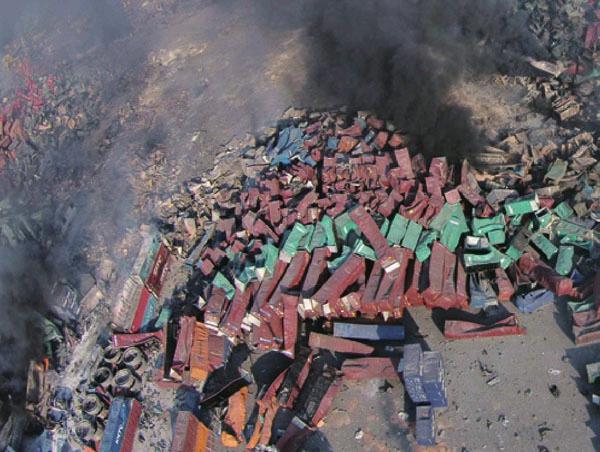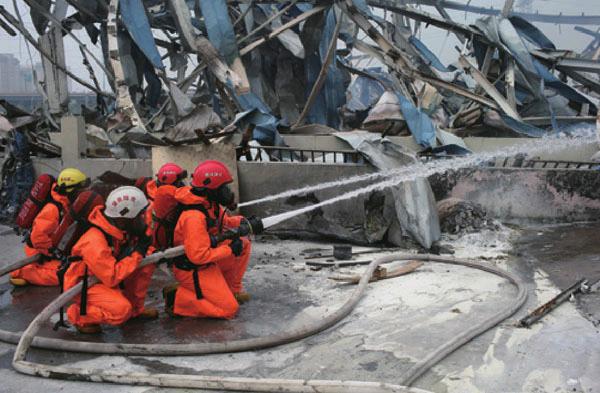THE BIG BANG
2015-09-08ByYuanYuan
By+Yuan+Yuan
Many residents were asleep when a blast powerful enough to register as seismic activity ripped through the Binhai New Area in the metropolitan city of Tianjin in north China on August 12.
The explosion, recorded at 11:30 p.m., came from a warehouse belonging to Tianjin International Ruihai Logistics Co. Ltd., used to store hazardous materials. People in nearby residential areas said flames lit up the sky in apocalyptic proportions and the blast blew up dust and clouds of acrid smoke dozens of meters into the air. The shockwaves were felt kilometers away, shattering glass across the city and leaving destruction in their wake.
Deadly explosion
Half an hour before the blast, a fire was reported at the warehouse and Tianjin fire brigade first dispatched 19 firefighters divided into three teams to the scene, before sending a further nine teams traveling in 35 fire engines there to ramp up rescue efforts.
By the time the reinforcements arrived at the site, however, the first three groups of 19 firefighters had, tragically, all been confirmed dead.
“I heard a huge bang while I was asleep,”said a resident surnamed Liu at Qihang Garden, a residential community only 800 meters from the site of the explosion. “My mind went blank for a few seconds and then I dashed to my parents bedroom. We all didnt know what had happened but the first reaction was to get dressed and go out.”
The elevator was damaged by the explosion and they had to walk down the stairs, which were splattered with blood.
Liu, who had bought the apartment in Qihang Garden in 2013, said that on the way down she had a clear view of the carpark located close to where the warehouse had minutes before stood, where more than 1,000 newly imported cars had been parked.“The explosion burnt those cars dark and grey,” said Liu. “It was like a scene of de-struction from a high-budget science fiction movie.”
The fallout in another residential community named Haigangcheng Community was even more severe. As the closest community to the warehouse, Haigangcheng is only 500 meters from the site of the explosion.
Yang Zhidan, a 35-year-old resident of the community, was also sleeping when the blast blew the windows off her apartments exterior and the doors within off their hinges, leaving her son and husband injured by shattered glass.
People rushed into the streets still wearing pajamas. Some thought it was an earthquake. A video clip taken by a witness showed heavy smoke high in the night sky, shortly after a loud eruption unleashed raging fire.
Du Wenjun, who lived further away than Liu and Yang, also experienced a Hollywood-style catastrophic scene in his home. He saw a mushroom cloud rising outside his window following the powerful thumps of the explosion.
The running crowds caused heavy traffic congestions on nearby roads. “Everybody was in panic and didnt know what to do next,” said Du.
By August 19, the explosion had resulted in 114 deaths, with more than 700 people injured and a further 65 missing.
Investigations underway
So why was a warehouse that stored a variety of hazardous materials located so close to a residential community?
While making an inspection in Tianjin, Premier Li Keqiang vowed that a thorough investigation of the accident was already underway and promised that there would be open and transparent disclosure of information to the public.
Chinas Public Security Minister Guo Shengkun arrived at the blast site in Tianjin at 5 a.m. on August 13 to direct rescue operations and visit the wounded in hospitals, making it his first priority to ensure the safety of peoples lives and security of property.
Speaking at a meeting on the rescue efforts, Guo also urged local authorities to continue to search for survivors, while correctly disposing of the dangerous chemicals around the blast site and preventing further accidents.
On August 16, the Supreme Peoples Procuratorate (SPP) announced that it had begun investigating whether there was any dereliction of duty involved in the warehouse explosions in Tianjin.
Two days later on August 18, Chinas cabinet, the State Council, announced that an investigation team headed by Executive Vice Minister of Public Security Yang Huanning had been established to probe the causes of the deadly explosions and said it would carry out a thorough investigation into the matter.
Tianjin Ruihai International Logistics Co. Ltd., the owner of the warehouse, was founded in 2011. As the companys documents show, it was granted temporary approval to handle hazardous chemicals from April to October of 2014. However, after the approval period expired, the company continued to handle these materials.
In June 2015, Ruihai obtained a port operation license from the authorities, which again allowed them to deal with dangerous chemicals. At the time of the blasts they were storing highly toxic sodium cyanide and potentially explosive potassium nitrate and ammonium nitrate.
As part of the certification process for the companys license, the company submitted a poll of 128 people living near the warehouse, which concluded that “most of the respondents support the project, with no objections.”
But conversely, residents in the neighborhood claim they didnt even know that the warehouse was in their backyard.
Vanke, the real estate developer for Haigangcheng that was damaged in the explosion, said that when it obtained the land in 2010, to the best of its knowledge, the warehouse stored ordinary goods and the real estate company had never been informed about the storage of any dangerous chemicals.
The freight volume handled by Ruihai stands at 1 million tons per year, with annual revenue exceeding 30 million yuan ($4.76 million).
On August 19, Tianjin Mayor Huang Xingguo, also Party chief of the city, claimed responsibility for the blasts and proposed building a memorial park at the blast site for the firefighters.
“As the chief of Tianjin Party committee and municipal government, I have an unshirkable responsibility,” Huang told a press conference.
As of August 20, the cause of the explosion is still under investigation.
The rescue
Chinese President Xi Jinping and Premier Li have urged all-out efforts to save the injured and minimize casualties.
On August 13, a team of 214 military experts specialized in handling nuclear and biochemical materials were sent to Tianjin. These personnel were sourced from the Chinese Peoples Liberation Army (PLA) Beijing Military Area Command, which also sent 45 medics to set up clinics 3 km from the blast site.
In addition, the Binhai New Area military department has organized 130 military personnel to assist with rescue measures, including the operation of drones and piloting helicopters to observe the site and douse flames with water.
On August 15, specialized anti-chemical warfare troops from National Nuclear Biochemical Emergency Rescue Team entered the core area of the blast site to search for possible survivors. There, they rescued a man who was found 50 meters away from the point of the explosion.
Measures have also been taken to prevent secondary disasters, such as using hydrogen peroxide to reduce the amount of sodium cyanide released from the chemicals, sending a taskforce to locate and measure the area contaminated by sodium cyanide, and prevent its spread into sewage. At the time of writing, no rescuer has fallen ill from chemical contamination.
To assist with rescue and cleaning-up operations, all people within a 3-km radius of the blast site have been required to evacuate the area.
On August 16, Premier Li arrived in Tianjin and paid his respects to those young firefighters who lost their lives in the disaster.
“They are all heroes and deserve the respect of the whole of society,” said Li, while visiting a brigade of the Tianjin fire department.
In the explosions aftermath, once things had been brought under control, some taxi drivers and private car owners were quick to volunteer to transport the wounded to hospitals. Hotels in the area also provided free accommodation to those residents displaced by the explosion, while other good samaritans lined up to donate blood for the wounded at the Tianjin Blood Center.
To further assist with accommodation, the No. 2 Elementary School of the Binhai New District Development Zone of Tianjin became a temporary settlement where around 1,000 residents have been relocated.
Hu Jianmin, a 60-year-old Tianjin resident, who lives more than 10 km away from the blast site, volunteered to deliver fruit and vegetables to people settled at the school.
One of his friends relatives was badly wounded from the blast and is still unconscious in the hospital.
The aftermath
The concerns of possible health threats are a real concern, most notably whether the hazardous materials have polluted the air and water in the area.
Hours after the explosion, the Tianjin Municipal Environmental Protection Bureau immediately began to monitor air and water quality, setting up 34 temporary monitoring stations for air and five for water. The water discharge portal to the sea has been closed.
Data on August 13 showed that the air quality remained within the normal range in the region near the warehouse. Epoxyethane, a harmful gas that could lead to cancer, in the most polluted area has stayed below 2 milligrams per cubic meter, compared with the stipulated hazardous level of 5 milligrams per cubic meter.
The marine monitoring results based on 177 seawater sample tests also showed that no hazardous chemicals were detected in water flowing from the blast site.
However, on August 18 volatile phenol, a toxic substance, as well as minute traces of sodium cyanide, were detected in water samples collected near Tianjin Port for the first time, according to the State Oceanic Administration.
The explosions also stoked concerns about dragging down the booming growth of the Tianjin Binhai New Area, a key industrial park that has made Tianjin one of Chinas fastest growing areas. The port of Tianjin also acts as a gateway from north China to the rest of the country, shipping roughly 40 percent of imported cars inland across the nation.
Responding to this, Huang, the mayor, said that the damage caused by the disaster needs further assessment, but would not affect the fundamentals of Tianjins economy.
“The areas affected by the blasts only have 176 companies, most of which do not run import-export business,” said Huang.
Social media has been awash with rumors following the explosion. On some Sina Weibo (microblog) accounts and the instant messaging service platform WeChat, comments like “toxic gas blown to Beijing,” “malls and markets looted,” and “no one survived within 1 km of the blast site” were commonly encountered.
Some accounts also masqueraded as being from relatives of the victims, attempting to swindle money through fraudulent charity fundraising.
According to the Cyberspace Administration of China (CAC), some celebrity bloggers posted“irresponsible” comments about the blast, causing their followers to panic by comparing the blast to the atomic bombs dropped on Hiroshima and Nagasaki in Japan during WWII.
“We take a zero-tolerance attitude toward websites spreading rumors after major disasters,” announced the CAC on August 16.
In an effort to tighten up control of dangerous chemicals and explosives, the State Council sent out an emergency notice on August 14, asking governments at all levels to reinforce the safety management of dangerous chemicals and explosives, strictly control the access threshold for industrial projects on these materials, and firmly implement special regulatory measures for highly toxic chemicals such as cyanide, as well as inflammable and explosive materials.
The notice says that the blast also revealed other problems, including the inadequate safety management of dangerous materials at ports, irregular practices among workers, weak emergency responses to incidents and lax supervision by authorities.
Since January, a series of accidents attribut-able to lax safety management in workplaces have occurred at quite a few locations across China.
On January 31, a plant in Linyi, Shandong Province, was hit by a blast during an overhaul of the plants equipment, killing four and injuring two others.
On June 10, a chemical factory in Yiwu of Zhejiang Province went up in flames after a tank containing methanol and acetic acid exploded.
On August 16, four days after the blast in Tianjin, a warehouse storing rubber and wood in Qingdao, a coastal city also located in Shandong, suffered a similar accident.
On August 17, Chinas industrial authorities demanded safety inspections on commercial explosive firms and ordered local regulators to conduct thorough safety checks on entities that deal with commercial explosives, with a focus on storage and safety regulations.
In line with this, Beijing has ordered inspections of all manufacturers or enterprises that deal with dangerous goods.
“The citys work safety department will inspect all manufacturers and explosiveproduct enterprises,” said Zhang Yankun, Vice Mayor of Beijing, on August 13.
Shanghai also launched widespread work safety inspections targeting enterprises involved in the production, operation, storage and transport of hazardous chemicals, inflammable materials and explosives.
Sunriow, a logistics company based in the Pudong New Area in Shanghai, which stores combustible and toxic materials, including essences and fragrances, was found to be storing products improperly under required categories during an inspection after the Tianjin blast.
Issues were also found with Givaudan Fragrances (Shanghai), a Swiss manufacturer of flavors and fragrances, which was found to be storing excessive quantities of hazardous chemicals.
“The inspections aim to achieve full coverage, zero tolerance, strict enforcement and be effective,” said Zhou Bo, Vice Mayor of Shanghai.
